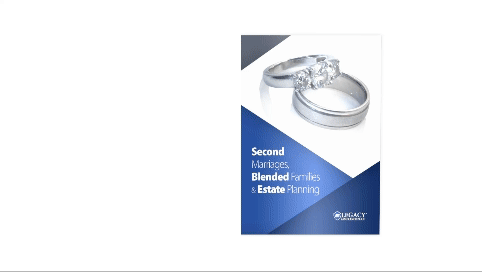Blended families often face unique challenges, particularly when it involves estate planning for second marriages. Striking a balance between protecting children from previous marriages and providing for stepchildren and a current spouse requires careful consideration and strategy.
Blended families, characterized by partners with children from previous relationships, bring a unique set of dynamics into estate planning. The process becomes more than just distributing assets; it’s about acknowledging and respecting the relationships and emotions intertwined within the family structure. Estate planning for blended families must be approached with empathy and a thorough understanding of the family's needs.
For those in second marriages, the estate planning process involves balancing the financial and emotional needs of different family members. It's about ensuring that children from previous relationships feel secure in their inheritance, while also providing adequately for a current spouse and any stepchildren.
How do you split an estate in a blended family?

Dividing an estate in a blended family presents unique challenges, calling for a thoughtful blend of legal strategy and personal judgment. The aim is to achieve a fair distribution that considers the diverse and sometimes competing interests of all family members, including biological children, stepchildren and the current spouse.
Here are some common strategies:
- Using trusts with specific provisions. Trusts are a versatile tool in estate planning for blended families. They can be tailored with specific provisions that dictate how and when assets are distributed. For example, a trust can be set up to provide for the current spouse during their lifetime, with the remainder of the assets then passing to children from a previous marriage upon the spouse's death. This ensures that the spouse is cared for, while also preserving the inheritance for the children.
- Tiered approach to asset distribution. A tiered approach can be implemented where assets are distributed to different family members at various stages or under different conditions. For example, immediate financial support could be provided to younger children for education and living expenses, while other portions of the estate are reserved for distribution at later stages, such as when the children reach a certain age or upon the death of the surviving spouse.
- Balancing equitable and equal distribution. In estate planning for blended families, it's important to distinguish between equal and equitable distribution. Equal distribution means each beneficiary receives the same amount, while equitable distribution takes into account each beneficiary's specific needs and circumstances. For instance, you might leave a larger share of the estate to a child who has special needs, while other children receive smaller but equal shares.
- Life insurance policies. Life insurance can be an effective tool in estate planning. You can designate different beneficiaries for your life insurance policy, such as leaving the policy proceeds to children from a prior marriage, ensuring they receive a portion of the estate regardless of other estate distributions.
- Property titles and beneficiary designations. Carefully reviewing and updating titles on properties and beneficiary designations on retirement accounts and other financial products is crucial. These designations often supersede instructions in a will, so ensuring they reflect your current wishes is essential for a fair distribution of assets.
- Gifting during lifetime. Sometimes, gifting assets during your lifetime can be a strategy to provide for family members according to your wishes. This approach allows you to see the benefits of your gifts and can help reduce potential conflicts after your passing.
- Legal and professional guidance. Given the complexities involved, seeking professional advice is recommended to develop an estate plan that suits your family's unique situation and ensures that all legal aspects are adequately addressed.
- Clear communication and documentation. Transparency and clear communication with all family members about your estate plan can alleviate misunderstandings and conflicts. Ensuring all your wishes are documented clearly in your will and other legal documents is key to a smooth estate distribution process.
Splitting an estate in a blended family requires a nuanced approach, balancing legal considerations with personal and family dynamics. By employing a combination of trusts, tiered asset distribution, life insurance policies and clear communication, you can create a fair and effective estate plan that respects and provides for all family members.
How does inheritance work in blended families?

Inheritance in blended families can become complex, especially when considering the rights of biological children versus stepchildren. It's crucial to have a well-drafted will and other estate planning documents that clearly outline your wishes. These documents should detail how you intend your assets to be distributed among your children, stepchildren and spouse, ensuring that your estate is divided according to your desires.
Who should come first in a blended family?
This question often brings to the fore the emotional aspects of estate planning. The answer depends on personal circumstances and family dynamics. It's not about ranking family members but rather about addressing each individual's needs and ensuring that the estate plan reflects the unique fabric of the blended family.
What are red flags for blended families in estate planning?
Some red flags in blended family estate planning include inadequate communication, assumptions about automatic inheritance rights and ignoring potential conflicts. Identifying these issues early and addressing them through clear communication and professional legal guidance is essential to prevent misunderstandings and disputes.
Using a trust and other estate planning tools for blended families

Estate planning tools like wills, trusts and specific legal clauses can help address the unique needs of blended families. As mentioned, for example, a trust can be set up to provide for a spouse during their lifetime, with the remaining assets then passing to children from a previous marriage.
A revocable living trust is created by drafting a trust document, often with the assistance of an estate planning attorney. This document outlines how the assets in the trust should be managed and distributed.
The person creating the trust, known as the grantor, transfers ownership of their assets into the trust. This can include real estate, investments, bank accounts and other personal property.
The grantor typically serves as the initial trustee, managing the assets according to the terms set out in the trust. This role includes investing assets, paying bills and making distributions as dictated by the trust.
A successor trustee is named to take over the management of the trust after the grantor’s death or incapacity. This successor trustee can be a spouse, family member, trusted friend or a professional trustee.
The trust document specifies how the grantor’s spouse is to be provided for during their lifetime. This can include regular distributions for living expenses, health care and other personal needs.
The trust can grant the spouse certain rights, such as the right to live in a marital home, the use of certain personal property or the income generated from trust assets.
The trust outlines the conditions under which the remaining assets will be distributed to the grantor's children from a previous marriage. This typically occurs after the passing of the surviving spouse.
The distribution to the children can be structured in various ways, such as lump-sum distributions, staggered distributions at certain ages or life milestones or continued management of the assets in trust form for their benefit.
With a revocable trust, the grantor retains the flexibility to amend the terms of the trust as long as they are alive and mentally capable. This allows adjustments to be made as family or financial situations change.
The trust also provides privacy and avoids the probate process, as the assets in the trust are not subject to court proceedings upon the grantor’s death.
During the grantor’s lifetime, the trust is typically treated as a "grantor trust" for tax purposes, meaning the grantor continues to pay taxes on any income generated by the trust assets.
Once a trust is established, it’s essential to ensure that all relevant assets are properly titled in the name of the trust (a process known as trust funding). Failure to do so may result in those assets going through probate, contrary to the intent of the trust.
Dealing with possible tax implications

In estate planning for blended families, understanding and managing tax implications is crucial. Estate and inheritance taxes can significantly impact the amount of wealth transferred to your loved ones. Families with large estates should consider strategies such as gifting assets during their lifetime or setting up trusts to minimize tax liabilities. Consulting with a tax professional can provide tailored advice to ensure that your estate plan is as tax-efficient as possible.
Communication and family involvement
One of the most critical aspects of successful estate planning in blended families is clear and open communication. It’s important to discuss your estate plans with all family members, including children from a previous marriage and your current spouse. This openness can help manage expectations, reduce potential conflicts and ensure that everyone understands and respects your wishes. Involving family members in discussions and decision-making processes can also foster a sense of inclusion and fairness.
Working with estate planning professionals
Estate planning for blended families can be complex, often requiring the expertise of professionals. An estate planning attorney can help with the legal intricacies and draft documents that reflect your wishes. Financial professionals can provide guidance on asset management and distribution strategies that align with your estate plan. Working with these professionals ensures that your estate plan is comprehensive, legally sound and tailored to the unique needs of your blended family.
Conclusion
Estate planning for blended families, while challenging, is essential for ensuring that both children from previous marriages and current spouses are provided for according to your wishes. It requires a delicate balance of legal strategy, tax planning and emotional intelligence. By understanding the unique needs of your family, communicating openly and seeking professional guidance, you can create an estate plan that brings peace of mind and security to all members of your blended family. Remember, the ultimate goal is to build a legacy that honors and protects the relationships that matter most to you.



